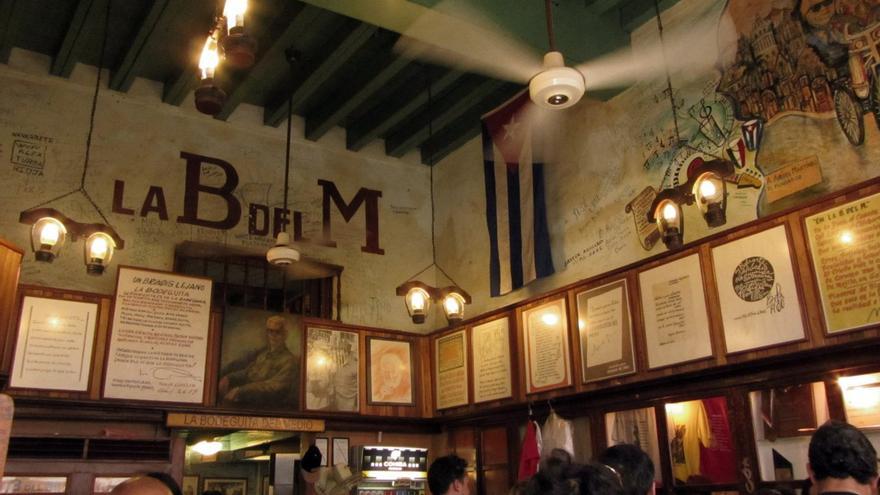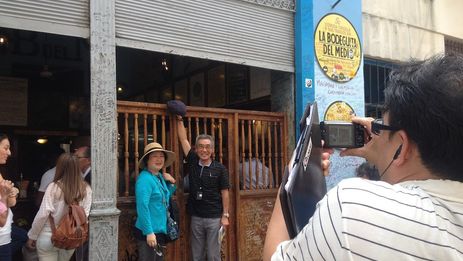
![]() 14ymedio, Zunlida Mata, Havana, 27 April 2018 — Tourists landing in Havana have, at a minimum, two goals: tour the city in an old convertible and have a mojito at La Bodeguita del Medio. The emblematic restaurant, which has just turned 68, owes its fame to the bohemian intellectuals who frequented it for more than two decades.
14ymedio, Zunlida Mata, Havana, 27 April 2018 — Tourists landing in Havana have, at a minimum, two goals: tour the city in an old convertible and have a mojito at La Bodeguita del Medio. The emblematic restaurant, which has just turned 68, owes its fame to the bohemian intellectuals who frequented it for more than two decades.
On 26 April 1950, No. 307 Calle Empedrado was inaugurated, between Cuba and San Ignacio, which would eventually become a symbolic site in the Cuban capital. Poems, songs, innumerable paintings and photographs have been inspired by this place specializing in traditional food, and its walls contain more than two million autographs.
Despite its international fame, La Bodeguita, as it is popularly known, has been losing prominence among Cubans and lacks a domestic clientele. Only the memory remains of that meeting place of painters, poets and journalists from the middle of the last century. A memory that travel agencies exploit and travel guides exaggerate.
The brand of La Bodeguita del Medio is registered by the Ministry of Tourism of Cuba and has at least eleven franchises in countries that include Mexico, Macedonia, Australia, Ukraine, the Czech Republic and Lebanon.
Houses that have rooms or the whole house to rent to foreigners, private galleries and even state institutions describe their location according to how many yards separate them from the restaurant-bar. “I rent two rooms on the corner of La Bodeguita del Medio,” Susana, a self-employed entrepreneur in Old Havana has printed on her business card.
“Dance classes five minutes walk from La Bodeguita del Medio,” reads an advertisement stuck on a nearby electric pole. “This is the golden mile of the old town,” says Omar, a young man who acts as a city guide for tourists who speak English or French. “No one who has a house here sells it,” he emphasizes.

However, beyond foreign visitors’ fascination for the small place with its striking sign with a yellow background and its doors in the style of the bodegas that sell food, the interior of the restaurant is becoming more and more like a postcard retouched for the eyes of tourists.
Last Tuesday, two Austrian tourists waited in the inner courtyard to be served sitting on the typical stools. In the place, crowded with diners, the waiters cleaned, set and served the tables automatically. Most of the chairs were occupied by Canadians, along with some Russians and Europeans who asked for the typical local dishes: roast pork, rice and beans.
“People here eat what you put on the plate, whatever it is, because they do not come for food but for the place,” a kitchen worker tells 14ymedio. “Most customers do not even know the difference between frijoles negros dormidos or reheated,” he says. “So the real business is that they pay luxury prices and consume an average product.”
Yanelis, who manages a small Spanish language academy, ate at the place the other day with three French students. “It’s a beautiful place, but sometimes I think I’m in a McDonald’s because everything is done very fast, the groups come and go and you can not see those gatherings that people like Ernest Hemingway held here.”
“The pork is tasteless and they don’t even make it with a mojo sauce. My rice dish looked like it contained portions from different times and the beans are mixed with flour and have a white cream on top,” she complains. “There are paladares (private restaurants) in this neighborhood that charge much less and offer a better meal, but La Bodeguita lives off its name.”
“Before the artists came and stayed for hours, my mother told me that it was common to find the poet Nicolás Guillén here and other known faces of the Cuban artistic avant-garde, but now you only see that kind of people in the photos that are in the walls,” she laments. “When my parents celebrated their tenth anniversary they came here and it was still a place for Cubans.”
One of the party with Yanelis asked for ropa vieja (literally ’old clothes’, a dish of shredded beef) one of the traditional dishes of Creole cuisine. The smal size of the portion, almost half of what they serve in a private restaurant, did not seem to matter much to the tourist. “My girlfriend asked me to take several pictures for her,” says the tourist.
“When I come with my students I warn them not to order the shrimp or the Cuban sandwich because they are a scam,” says the Spanish teacher. “But there are people who order that because they don’t come here to be filled up, but to say that they ate at La Bodeguita del Medio or to take a selfie and post it on Facebook.”
Roberto worked almost five years at the bar. “That is a place where people would kill to be, and you can line your pockets there,” he says. “Most of the mojitos sold are made with rum that is not what the label says or that the employees themselves buy from the outside,” he says.
“Everyone who works at La Bodeguita wants to open it every day and keep it full, so you often have to buy your own mint, rum and even ice because they do not arrive on time from the state, but that’s no problem because the investment is worth it with the profits you get,” he says.
“In the time I worked there, I started out buying a motorbike, then I was able to exchange my house for a bigger one and I paid for my two children to leave the country,” he says. After five years he lost his job because “they hired another bartender who paid more, because to be behind that bar you have to hand out a lot of money and there are many eyes on that square.”
Outside the restaurant-bar, a lady with a huge cigar in her mouth charges one convertible peso (roughly $1 US) for each photo taken. The tourists approach and smile believing she is a resident dressed in typical clothes but her sitting there is a job that she has done, religiously and for almost two decades, for more than eight hours each day and the cigar never seems to be lit.
“Every so often they come to film some program or a movie,” says Osniel, a resident of a dilapidated tenement who has a business selling small oil paintings of the façade of La Bodeguita. “It’s been more than two years since the American actor Don Cheadle recorded an episode of the House of Lies series,” he recalls and shows a photo that was taken nearby.
Osniel, however, does not remember any Cuban artist who has been there recently. “Famous Cubans? No, the Cubans do not come here.”
__________________________
The 14ymedio team is committed to serious journalism that reflects the reality of deep Cuba. Thank you for joining us on this long road. We invite you to continue supporting us, but this time by becoming a member of 14ymedio. Together we can continue to transform journalism in Cuba.
